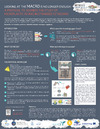Please use this identifier to cite or link to this item:
https://accedacris.ulpgc.es/jspui/handle/10553/106640
| Title: | Looking at the MACRO is no longer enough: A protocol to address the study of microplastic intake in stranded cetaceans | Authors: | Montoto Martínez, Tania De La Fuente Marquez, Jesus Puig Lozano, Raquel Marques, Nuno Fernández Rodríguez, Antonio Jesús |
UNESCO Clasification: | 240119 Zoología marina 310907 Patología |
Keywords: | Megafauna Microplastics Necropsy Protocol Stranded cetaceans |
Issue Date: | 2020 | Project: | Fomento de la actividad ecoturística de whale watching como modelo de desarrollo económico sostenible mediante la protección y conservación de las poblaciones de cetáceos y su puesta en valor como patrimonio natural de la Macaronesia | Conference: | MICRO2020. Fate and Impacts of Microplastics: Knowledge and Responsibilities | Abstract: | Marine debris can impact biodiversity in a number of ways, and its effects may vary depending on the type and size of the debris and the organisms that encounter it [1]. Since the first evidence of a marine mammal's interaction with plastic intake, there have been a number of studies on this subject, together with alarming images of stomachs full of marine debris and a growing concern about it. However, very little is known about the presence of microplastics in higher trophic level species such as cetaceans [2]. Up to more recently, they were primarly focused on the study of particles larger than 2.5 cm, and therefore failing to assess the microlitter presence, which remains a challenging task due to large gut content volumes and the difficulties of sampling following careful airborne contamination prevention protocols. Working with stranded cetaceans (n=12), which represent a significant opportunity to study the interaction of marine fauna with plastic debris, we have validated a protocol for microplastic ingestion studies that serves to obtain samples from different multidisciplinary teams (i.e. veterinary and marine sciences schools), without interfering in the work of any of the parties [3]. The successful table set up used for the extraction of microplastic particles from the gastrointestinal contents was proofed advantageous and applicable by any research group that already counts with the necessary facilities to perform cetaceans autopsy analysis, fulfilling the harmonisation needs as explicated by Panti et al. [4]. This approach is fully compatible with necropsy protocol in cetaceans [5], and at the same time complies with the recommendations for reporting ingested plastics in marine megafauna [6]. The proposed workflow allows the collection of valuable data for different interdisciplinary research teams, aiming to harmonize data, facilitate large-scale comparisons of plastic ingestion and also give scientific basis to future conservation policies. | URI: | https://accedacris.ulpgc.es/handle/10553/106640 |
| Appears in Collections: | Póster de congreso |
Page view(s)
470
checked on Sep 27, 2025
Download(s)
143
checked on Sep 27, 2025
Google ScholarTM
Check
Share
Export metadata
Items in accedaCRIS are protected by copyright, with all rights reserved, unless otherwise indicated.
